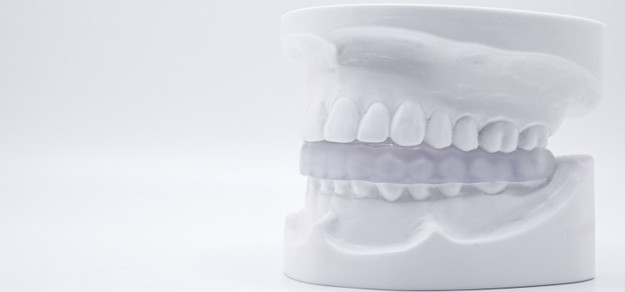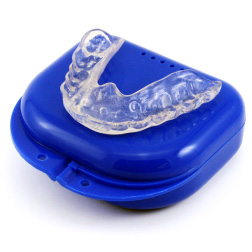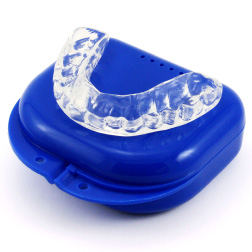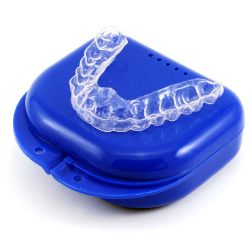Night Guard For Bottom Teeth: Pros And Cons
10th Sep 2025

A mouth guard protects your teeth and jaw from the damaging effects of teeth grinding (bruxism). If your dentist recommends a night guard, the key question becomes: Should you wear the night guard on your bottom teeth or upper teeth?
When making the choice, many people find that lower night guards feel more comfortable and are easier to wear regularly.
Why Mouth Guard Wearers Choose Night Guard for Bottom Teeth vs. Upper Teeth

There aren’t many structural differences between upper and lower night guards—both are typically made from the same materials. The main difference lies in which set of teeth the guard covers. Many people prefer a lower night guard for several reasons, though an upper guard may be more suitable in specific situations.
Benefits of Lower Night Guards
More Comfortable for People with Gag Reflex
A lower night guard doesn’t come into contact with the roof of the mouth, which can trigger a gag reflex. This makes it ideal for those with sensitive gag reflexes.
Better Fit for Individual Dental Anatomy
Each person’s dental anatomy is unique. For some people, they may find a lower night guard easier to get used to and more comfortable to wear.
Situations Where an Upper Night Guard May Be Better
Tongue Placement Concerns
Some people feel that a lower night guard interferes with tongue movement, making it difficult to rest or breathe comfortably. An upper guard might provide a better solution in these cases.
Comfort from Familiarity with Sports Mouthguards
If you’re used to wearing a sports mouthguard on your upper teeth, you may find an upper night guard more familiar and easier to adjust to.
Protecting Dental Work
Your dental work can also determine which type of night guard is better:
- Veneers on your top front teeth? An upper guard can offer better protection.
- Dental implants, retainers, or dentures? The location of these elements may dictate whether an upper or lower guard is more suitable.
Note: if you have dental work, it's best to consult your dentist for the recommended guard placement.
Related Articles:

- Most Popular
- Hard Outside, Soft Inside
- 2MM Thick
- Moderate / Heavy

- Most Durable
- Hard Materials
- 1.5MM Thick
- Heavy / Severe

- For Day Time Use
- Thin, Barely Visible
- 1MM Thick
- Light / Moderate

- For Clenching
- Flexible & Soft
- 1.5MM Thick
- Light / Moderate
Availability of Night Guard for Bottom Teeth Depending on Type
Both upper and lower night guards are available, but the availability and ease of purchase can vary depending on the type of guard. Here’s a breakdown of the common options:
Over-the-Counter Night Guards
Upper night guards are easier to find than lower ones, as most one-size-fits-all options are designed for the upper teeth. Lower night guards are less common in stores but can still be found at retailers like Amazon and Walgreens.
Boil-and-bite guards, which are softened in hot water and molded to fit, are a popular over-the-counter option, though not all are available for both upper and lower teeth.
Custom Night Guards
Custom-fit night guards are made in a dental lab to fit either the upper or lower teeth precisely. The process begins with an impression of your teeth, which is used to create a snug, comfortable guard tailored to your bite. For those needing a secure fit and maximum protection, a custom night guard is the most reliable option.
Soft, Hard, and Hybrid Night Guards
Upper and lower night guards are available in all (3) materials:
Soft night guards – Ideal for light teeth grinding.
Hard night guards – Recommended for heavy grinding or clenching.
Hybrid (dual-laminate) night guards – Provide a balance of comfort and durability.
Importance of Mouthguards for the Oral Health of Teeth Grinders

No matter which type of night guard you choose to protect your teeth from teeth grinding and clenching, the important thing is that you get one. According to Melissa Leone DDS, “Nightguards are an easy way to prevent the wear and damage that teeth-grinding causes over time.”
When you clench and grind your teeth, your jaw muscles can become sore, you can develop sensitive teeth, and you can even develop problems with your temporomandibular joint. This may lead to jaw pain and dysfunction known as TMJ.
Protecting your teeth from bruxism is key to avoiding broken teeth and orthodontic work. Additionally, bruxism can be a sign of sleep apnea, so while it’s imperative you begin protecting your teeth as soon as possible, you should also speak to your primary care provider about sleep apnea.
Note: A study published in Dental Traumatology recommends custom-fit mouthguards for people who grind their teeth. These guards offer better comfort, protection, and durability compared to store-bought versions, making them a smart long-term investment
Related Articles:
FAQs About Night Guards for Bottom Teeth
1. How long does it take to adjust to a lower night guard?
Most people need about 1-2 weeks to fully adjust to wearing a night guard. During the initial nights, users may feel discomfort or excessive salivation, but these issues generally subside with consistent use.
2. Can you wear both a top and bottom night guard?
Wearing both a top and bottom night guard simultaneously is uncommon and generally unnecessary. It may limit jaw movement and cause discomfort.
3. Is a top or bottom night guard better?
There's no best choice for everyone—it depends on your comfort, bite, and grinding habits. Some prefer lower guards because they feel more natural, while others find upper guards offer better protection.
Choosing a Night Guard
There are many reasons to choose a lower night guard: they trigger the gag reflex less than upper splints, they’re less likely to fall out, and they’re typically tolerated better. Once you’ve made a decision about which type of night guard is best for you, Pro Teeth Guard can help create a comfortable and cost-effective guard.
At Pro Teeth Guard, you can get a custom-fit mouthguard at an affordable price. We make our night guards in a professional dental lab, and every night guard is guaranteed to fit comfortably with our 110% money-back guarantee and 1-year warranty.
References:
- McClelland, C., Kinirons, M., & Geary, L. (1999). A preliminary study of patient comfort associated with customised mouthguards. British Journal of Sports Medicine, 33(3), 186–189. https://doi.org/10.1136/bjsm.33.3.186
- Sliwkanich, L., & Ouanounou, A. (2021). Mouthguards in dentistry: Current recommendations for dentists. Dental Traumatology, 37(5), 661–671. https://doi.org/10.1111/edt.12686
- Leone Dental (Leone, M. D.). (n.d.). Mouthguards. Retrieved July 15, 2025, from https://www.leonedentist.com/mouthguards/

- Most Popular
- Hard Outside, Soft Inside
- 2MM Thick
- Moderate / Heavy

- Most Durable
- Hard Materials
- 1.5MM Thick
- Heavy / Severe

- For Day Time Use
- Thin, Barely Visible
- 1MM Thick
- Light / Moderate

- For Clenching
- Flexible & Soft
- 1.5MM Thick
- Light / Moderate
